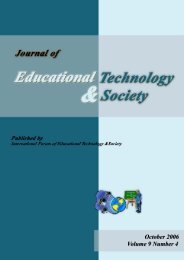Student Engagement: What do we know and what should we do?
Student Engagement: What do we know and what should we do?
Student Engagement: What do we know and what should we do?
You also want an ePaper? Increase the reach of your titles
YUMPU automatically turns print PDFs into web optimized ePapers that Google loves.
come if <strong>we</strong> teach in a way that meets the expectations <strong>we</strong> have of <strong>what</strong> the<br />
students want. At some point, <strong>what</strong> <strong>we</strong> are <strong>do</strong>ing is killing higher education’<br />
(Carlson, 2005, p. 2).<br />
Ho<strong>we</strong>ver, as logical as this consideration might seem, the majority of the literature calls<br />
for changing education, most authors practically implore change – or transformation – of<br />
education <strong>and</strong> pedagogy in Kindergarten through post-secondary; they strongly feel that<br />
<strong>we</strong> fail to meet the needs of students who have grown up in a digital world <strong>and</strong> are<br />
heading into different cultural <strong>and</strong> economic futures that are rich in ever-advancing<br />
technology <strong>and</strong> information (Project Tomorrow, 2010). Today’s world absolutely<br />
requires collaborative critical thinkers, creative <strong>and</strong> courageous innovators, <strong>and</strong> true<br />
lifelong learners (Prensky, 2005; Tapscott, 1998; Robinson, 2009).<br />
How can <strong>we</strong> improve student engagement? The themes <strong>and</strong> ideas that surface most<br />
often in the literature are: embedded collaboration, integrated technology, inquiry-based<br />
learning, assessment for learning, <strong>and</strong> making learning interdisciplinary <strong>and</strong> relevant to<br />
real life. “Significant changes in teaching <strong>and</strong> learning are possible, particularly when<br />
interactive technologies are involved. These changes promise to better engage the Net<br />
Generation <strong>and</strong> the adult learner. But <strong>what</strong> will it take to turn the promise into success?”<br />
(Ramaley & Zia, 2005, p. 8.15). The research suggests that successful, student-engaging<br />
classrooms often combine these aspects:<br />
1. Learning that is relevant, real, <strong>and</strong> intentionally interdisciplinary – at times<br />
moving learning from the classroom into the community.<br />
2. Technology-rich learning environments – not just computers, but all types of<br />
technology, including scientific equipment, multi-media resources, industrial<br />
technology, <strong>and</strong> diverse forms of portable communication technology<br />
(Project Tomorrow, 2010).<br />
3. Positive, challenging, <strong>and</strong> open – sometimes called “transparent” learning<br />
climates – that encourage risk-taking <strong>and</strong> guide learners to reach coarticulated<br />
high expectations. <strong>Student</strong>s are involved in assessment for<br />
learning <strong>and</strong> of learning.<br />
4. Collaboration among respectful “peer-to-peer” type relationships bet<strong>we</strong>en<br />
students <strong>and</strong> teachers (horizontal organization model); Professional Learning<br />
Communities working together to plan, research, develop, share, <strong>and</strong><br />
implement new research, strategies, <strong>and</strong> materials.<br />
5. A culture of learning – teachers are learning with students. Language,<br />
activities <strong>and</strong> resources focus on learning <strong>and</strong> engagement first, <strong>and</strong><br />
achievement second.<br />
We need to <strong>do</strong> more research. Educators interested in student engagement must<br />
more deeply analyze assumptions about pedagogy, about the purpose of education,<br />
<strong>and</strong> about the so-called “new students” <strong>and</strong> the world <strong>we</strong> are launching them into.<br />
The literature repeatedly states the need to re-examine our assumptions about learning<br />
<strong>and</strong> about the learners; there is a common call to revisit traditional teaching pedagogy<br />
<strong>and</strong>, if not change altogether, at least infuse our daily classroom offerings with<br />
student engaging pedagogy based on more recent neurological, cognitive,<br />
<strong>Student</strong> <strong>Engagement</strong>: <strong>What</strong> <strong>do</strong> <strong>we</strong> <strong>know</strong> <strong>and</strong> <strong>what</strong> <strong>should</strong> <strong>we</strong> <strong>do</strong>? 5












